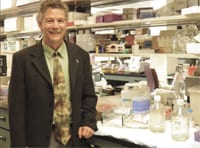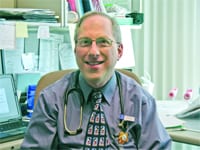Lifesaving Measures Rays of Hope Funds New Breast-cancer Research Center
Every year, thousands of people turn out for the annual Rays of Hope walk in Springfield and Greenfield, raising funds to support local breast-cancer programs. Many have also made donations in hopes that researchers will discover the cure for the devastating disease that affects one in every eight women.
The event has raised $9.5 million and grown from 500 people to 20,000 walkers in 18 years. From its inception, a critical component of the mission has been to ensure that all of the money raised stays in Western Mass. It has been used to fund a wide variety of individual research projects, as well as counseling and support programs, as well as alternative treatments such as Reiki, healing touch, therapeutic massage, and art therapy at the Cancer House of Hope in Springfield and Westfield and the Cancer Connection in Northampton, among others. Initiatives such as the American Cancer Society’s ‘We Can Weekend’ have also benefited.
But Rays of Hope aims to shed even more light, help, and hope with its newest venture. The nonprofit organization is making a $1.5 million donation to establish the Rays of Hope Center for Breast Cancer Research at the Pioneer Valley Life Sciences Institute (PVLSI) on Main Street in Springfield.
The donation will be made in installments over a five-year period and will be a collaborative effort that will join resources and coordinate work being done by clinicians at Baystate Medical Center, scientists at UMass Amherst, and the PVLSI.
The decision to fund the center was made by the Rays of Hope Community Advisory Board. In addition to the hundreds of volunteers who provide input and help to the organization, the board works to determine how to spend the funds raised in a manner that will benefit the community.
“The members meet 10 times each year to discuss which programs would be most beneficial to the community,” said Carol Baribeau, a breast-cancer survivor, member of the Community Advisory Board, and director of the Annual Fund and Events for the Baystate Health Foundation
Last year, the group was presented with a proposal by Drs. Grace Markari-Judson and Joseph Jerry to establish a Rays of Hope Center for Breast Cancer housed at the Pioneer Valley Sciences Institute, and Baribeau said they were unanimous in their approval.
“The board was thrilled to be able to do this. The naming of this center is yet another indication of the enduring legacy that Rays of Hope and all of its participants have created in our community,” she said. “It sets Western Mass. apart and is a wonderful collaboration. Plus, the possibilities of what can be done and discovered here make us proud to say we are doing this.”
Clinical Considerations
Makari-Judson concurred. “We certainly are thrilled with the new collaboration involved in putting this research center together,” said the medical director of the Comprehensive Breast Center (which is part of the Baystate Regional Cancer Program) and co-director of the new Rays of Hope Center for Breast Cancer. “It will help us come full circle.”
She explained that one of the most important pieces is the transitional research that will occur there. “It will be a two-way street. We will make observations in the clinic which will be used to stimulate our colleagues in the lab to go in new directions,” Makari-Judson said.
“The flow of knowledge from lab to clinic and clinic to lab is what is so wonderful about this. We have scientists from the PVLSI, from the University of Massachusetts Amherst, and clinical investigators from the Baystate Comprehensive Breast Center who work in a wide variety of departments. But they all share one thing in common. They want to focus on, understand, and promote research in diseases of the breast.”
One of the new center’s major focuses will be the connection between breast cancer, obesity, and metabolic syndrome, a complex illness whose symptoms include obesity, hypertension, and early indications of diabetes, which can increase breast-cancer risk.
Makari-Judson says the PVLSI has been working to identify risk factors for breast cancer and biomarkers that put women at a higher risk of developing the disease.
Their findings show that obesity after menopause increases the risk of breast cancer. “And at the time of diagnosis, women who are obese have a worse prognosis than other women,” she said. “Regardless of where a woman starts out, weight gain can be associated with a high risk of reoccurrence of breast cancer.”
The most unique component in the new center will be an advocacy group of six to eight individuals from the community who will ensure that the desires of the public are represented and prioritized “as we shape the future of our research,” she noted, adding that advocates are used across the country on research-review boards for the government.
“For example, we may look at who gets breast cancer and what issues we need to address, since breast cancer in Springfield may not be the same as it is in California or England.”
In fact, studies show that breast-cancer patients in Springfield are 10 years younger, on average, than in the rest of the country, so local research will focus on causes and preventative measures.
Special Focus
Jerry, who was recently appointed director of the PVLSI and co-director of the Rays of Hope Center for Breast Cancer Research, will handle a different aspect of the operation.
“The scientists provide technical skills needed to uncover the molecular pathways underlying differences in risk among women — why one woman’s risk is high, why another person’s is low, and why treatments differ,” he said. “I have worked with clinicians at Baystate for more than 15 years studying how breast cancer develops and the reasons why the breast is so prone to cancer.” He also studies factors that can prevent breast cancer.
Jerry said women who have a full-term pregnancy prior to age 30 are less likely to develop breast cancer. “Changes during pregnancy provide targets for both prevention and treatment. We are identifying the critical changes and are using this information to improve diagnostics and develop therapies to prevent breast cancer,” he said.
But the main focus of the research center will be to focus on the intersection of diabetes, obesity, and breast cancer. “Right now, we know that obesity continues to be a growing problem, and we need to develop diagnostics to identify individuals who are at the greatest risk,” Jerry said. “We want to try to discover what it is about obesity that creates a tendency for more aggressive disease.”
Another problem they want to focus on is premalignant lesions in the breast. Fewer than 20{06cf2b9696b159f874511d23dbc893eb1ac83014175ed30550cfff22781411e5} of women who have the lesions develop breast cancer, so it is not standard practice to treat them. “But up to 54,000 cases of breast cancer could be avoided annually if we knew who to treat,” Jerry said, “so we are trying to develop tests to distinguish the minority who should be treated, and for the majority, they can be spared the anxiety that can accompany a diagnosis of premalignant lesions.”
In addition, teams including polymer scientists and chemists at UMass are working to develop methods to deliver chemotherapy drugs to make them more effective.
In short, the Rays of Hope center will draw together multiple disciplines and strengths from Baystate Medical Center, UMass Amherst, and the PVLSI under a new infrastructure, using their resources to speed research and expand it, he said.
Reaching Out
Jerry agreed that Rays of Hope’s vibrant community-advocacy group is a key component to making the program a success. “Cancer research shouldn’t be done in a vacuum or in a silo of a hospital or research facility. It needs to involve all of us working together to create solutions.”
And all of the participants who participate in the annual Rays of Hope walk, as well as those who take part in studies and help define the needs of the community, are critical to continuing the mission of raising money and using it to help local residents.
The program has come a long way in 18 years, Baribeau said, but “the center will bring us full circle and is a wonderful legacy.”



